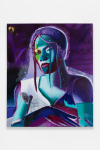Midnight Spill, 2023
Perrotin, Hong Kong
Midnight Spill (Video, Press Release)
Katherina Olschbaur has created a dramatic moon-dog show at Perrotin Hong Kong with a set of portraits in the style of Beethoven's Piano Sonata No. 14 in C-sharp minor. Produced over the past year, the series invokes tenderness, coldness, affection, and silent commiseration, the different movements on the canvas reflecting changes in rhythm, emotion, and light. Olschbaur gazed at the mirage of her own projection in the dark night, like the moon cloaked by folds of clouds. In the gulf between subject and object, glints of light appeared.
Although some of Olschbaur's portraits are based in reality – a friend leaning on a sofa in the studio (Asuka, 2022-2023), a re-examination of the artist's self-portrait (If you want to keep knowing me, you can telephone me now and then, 2022-2023), Rococo ornamentation and the history of drag costume in the 1970s and 1980s (Purple Gaze, 2022-2023) – the figures she portrays often seem distant and unreachable. Their faces resemble those of religious authorities or Greek statues: they either look directly at the viewer or refuse to interact, their eyes cast downwards. Graceful and detached, they seem to stare at us anyway, regardless of our own gazes.
This otherworldly quality is a result of Olschbaur's use of light. The artist masks the vibrancy of red, yellow, blue, and purple with a neon-like coolness, akin to the stained-glass magic of a church dispersing and muting natural light; the dazzling glare is infused with a cooler shade, pouring down on the viewers' upturned faces, turning their complexions into a subtle interplay of light and shadow. For Olschbaur, each color is imbued with a complicated 'personality', the result of a myriad of lived episodes, because what has been remembered are „memories of the color and the feelings instead of a specific face or place.“ Olschbaur says, „every color creates a certain space that embraces me, feelings I cannot name, very different and complicated mood[s].„ Thus, when extreme darkness is juxtaposed with extreme brightness, when “one (color) talks to another,“ the artist generalizes and sublimates both 'ambiance' and 'mood' using a concise visual language.
Instead of rigid cuts and edits from archetypes in historic paintings, all of the figures are strongly grounded in images retrieved from the subconscious. It is therefore hard to trace the actual origin of a given figure, transforming the work into an 'Olschbaurian resonance' bearing the marks of Maria Lassnig, R. B. Kitaj, and Miriam Cahn. Countless „small times“ are inserted into the painting, reminding us of those sweet, cozy moments we all have experienced. A rainy street is captured by a tiny, unremarkable gray finish on the giant canvas, while the morning glory over the lake behind the characters comes to life against horizontal, colored stripes. Tremors of nature — mild, flat, and impressive — manifest themselves in the slices of life Olschbaur collects. „Looking out of my window now, the sun is setting right on the snow-capped mountain, making me want to go back to painting again.“
The shadow of the pandemic can be implicitly felt in Olschbaur's latest works, the theme of 'wrestling' found in her previous series still remains. It does not address a specific subject matter, but rather points to 'taboos' and 'transgressions' per se.
Although the artist borrows from myth and religion, her works of the past two years are not devoted to any specific character or account. Growing up in Austria, a predominantly Catholic country, the daughter of a Protestant priest, the artist went from carelessly and mischievously breaking the rules, to intentionally shaking the established authority and order, to gradually redirecting her focus towards the macroscopic themes of religious and social history. Her rebellious experiments occurred both on the canvas and in real life. Her bold forms, bizarre colors, and sharp lines cut through the taboo-filled secular world and the absolute authority that prevails in it; violence to suppress violent desires, legitimized disciplinary measures, a man's whip raised to forge divine realms crushed by animal-like spiritual sensuality; the reborn and the dead constantly reappear in discussions of religion, femininity, and mythology; exploding debates about control, discourse, physical punishment, and spiritual freedom. Art, religion, history, and selfhood are disrupted by a primitive force (like Jacob's) until the simultaneous arrival of God's blessing and punishment.
When night falls, the prelude to a drama unfolds, veiling 'transgressions'. The element of night, as Olschbaur observes, is a constant presence in her works from 2020 to the present: „At night, the boundaries are blurred, people seem closer, worries seem less, (and) moments shared with people are healing.“ Compared with recent work dating to 2021, these newly created works are somewhat gentler, but they still exhibit the artist's aesthetic roots in the light of the classic Venetian School and the tragic overtones of Greek mythology. The night in Olschbaur's work is reminiscent of Tintoretto. Instead of a clear and bright world and a „sweet and pearly peace“, it seeks darkness, its hazy visions igniting „the strength of flame and coruscation of lightning and flash of sunshine on armor and on points of spears.“
Great nothingness and darkness envelop the world. In the paintings' flow of faces and brush strokes, fierce struggles and gasps of exhaustion reverberate amidst the city's hustle and bustle. Under a moon-dog night, Olschbaur has created magic on her canvas, the moon gazing wordlessly through the gulf at her own refracted self-image. „At last! the tyranny of the human face has disappeared, and I shall no longer suffer but through myself.“
Press coverage: W Harper's Bazaar, W Magazine China Feature, Nylon China


























